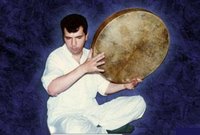
By Peyman Nasehpour - Persian Mirror - U.S.A.
Tuesday, September 12, 2006
A drum (its generic name in Persian, tabireh) is a percussion instrument, a hollow object with a membrane stretched over one (some) end(s), played by beating with hands or the sticks. In Iran (formerly known as Persia) different drums are played both in art and regional music. In this article, the author will introduce the main drums of Persia that are more or less the most popular ones.
Tonbak (Persian goblet drum)
Goblet drums are played in different areas, from Asia, Europe and Africa. Among them, tonbak, Arabic darbouka and African djembe are getting popular in the world.
Tonbak, a goblet shaped drum, is the chief drum played in Persian art music, though it is played in folk music too. Also a larger version with the name zarb and a clay body, it is played in zourkhaneh (Persian traditional gymnasium).
The history of tonbak, with the Pahlavi (pre-Islamic language of Persia) name, dombalak, goes back to thousands of years ago.
Tonbak, in the past, was considered an accompaniment instrument. Thanks to great efforts of the late maestro Hossein Tehrani (the father of modern tonbak), people's opinion changed a little bit and this drum had a more important role in Persian art music and was considered as a solo instrument.
Dayereh (Persian frame drum)
Frame drums are among the most popular drums played in four corners of the globe.
Dayereh is one of the most popular drums played in folk music of Iran. Different versions of dayereh with different names are played in different regions of Iran.
Perhaps the very well promoted version is the ghaval (Azerbaijani frame drum), the drum played by Azeri singer in the Azerbaijani art (called mugham music) and folk music (called ashighlar music). One of the most notable ghaval players of Iran is the maestro Latif Tahmasebi-zadeh, who promoted the ghaval as the solo drum in Iran and Republic of Azerbaijan.
The history of dayereh, with the Pahlavi name, dareh, goes back to pre-Islamic ages. Dayereh is sometimes played in Persian art music.
Daf (Persian frame drum)
Daf, as a drum played in Sufi music of Iran, is one of the most popular drums mentioned in Persian literature by very famous Persian poets such as Rumi and Hafiz. After the establishment of 'Shayda Ensemble', daf was played and popularized by Bijan Kamkar, the daf player who created the modern style of daf, beside the traditional style played in khanghah (Sufi temple).
The history of daf, with the Pahlavi name, dap, goes back to pre-Islamic ages and today, thanks to many daf players it has become that popular and played in different genres of Persian music that it is considered the second national drum of Iran, beside the tonbak that is the first national and the most important drum of Iran.
Dohol (Persian cylindrical drum)
Dohol is the also one of the most important drums played in Persian regional music. It is a very loud drum mainly played with drumsticks, in outdoors.
Dohol is the main accompaniment of sorna (Persian oboe), mainly played in festive occasion.
Some versions of dohol are played with hands too.
Naghareh (Persian kettledrums)Naghareh, is also another popular drum, played in different regions of Iran. Its size can vary from very small to huge ones that were tightened on elephant-backs in war fields in order to accompany karna (Persian large sized wind instrument) for the courage of soldiers.
Some believe that tabla (famous Indian drum) is originated in naghareh, Indian dhol (similar to Persian dohol) and pakhawaj (Indian barrel shaped drum).





No comments:
Post a Comment